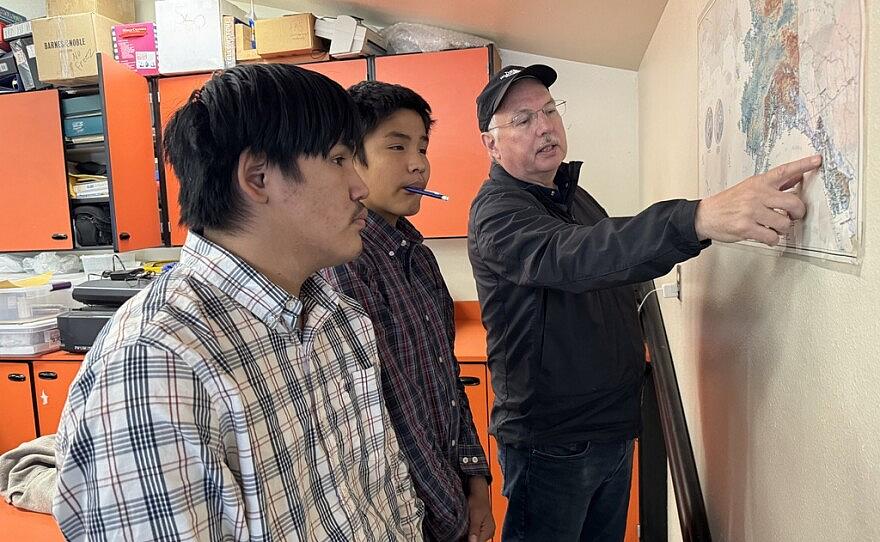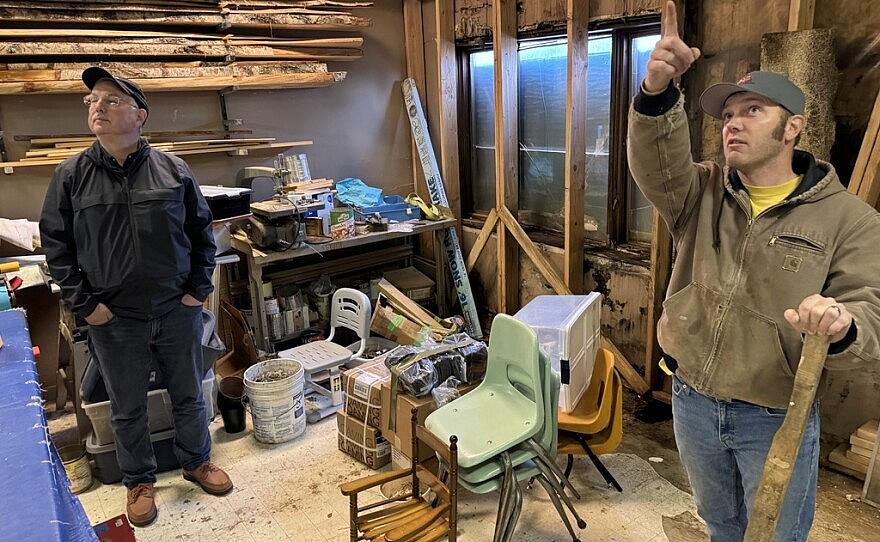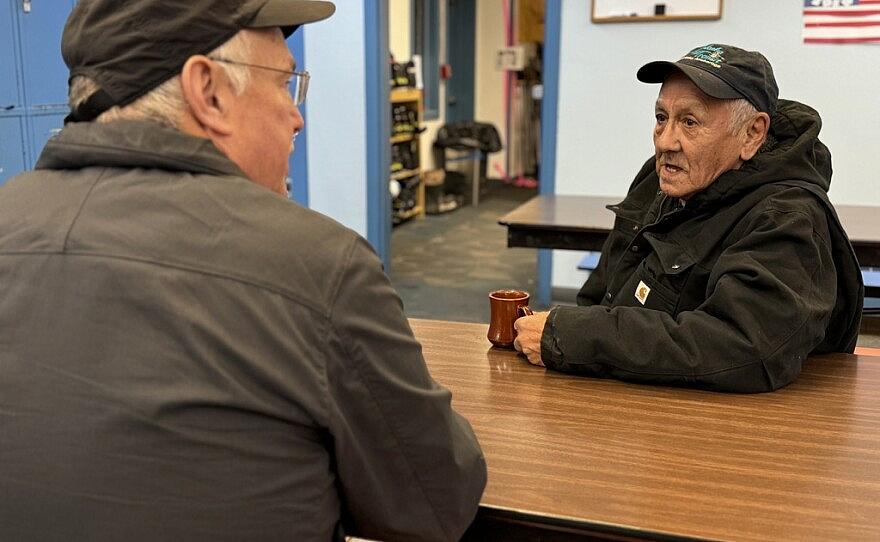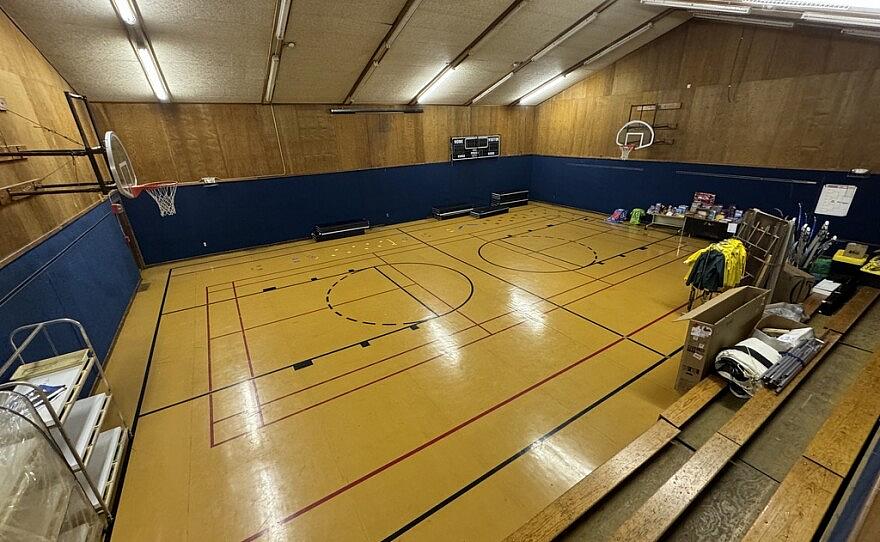Without infrastructure investment, some rural communities may not be able to have school at all
The story was originally published in KYUK with support from our 2024 National Fellowship.

Rep. Bryce Edgmon (I-Dillingham) (right) meets with high school students at Sleetmute's school.
Emily Schwing / KYUK
AUDIO TRANSCRIPT:
EMILY SCHWING: Alaska’s legislature and the governor are divided over education funding. And this year, most of the debate centers around the BSA - Base Student Allocation. This is the amount of money the state is willing to put toward each individual student. It pays for things like textbooks and teachers’ salaries. For Kay Andrews, this debate overlooks something else.
KAY ANDREWS: Please go visit our schools. Come out to the rural areas. Take a look at the leaking roof and the pots and the pans that are underneath it. And we don’t have space for other students.
Andrews is school board president of the Bristol Bay area’s Southwest Region School District. Increasing the BSA won’t help cover what she’s talking about: money to fix things like failing heating systems, malfunctioning fire alarms, and broken sewer lines isn’t supposed to come from the BSA.
In February, the Senate and House Education Committees heard from Andrews and several others from rural Alaska who testified about the serious public health and safety risks they face inside the state’s public school buildings.
ANGELA OMEDELINA: Hello, my name is Angela Omedelina. I’m a junior representative at Nome-Beltz High School. Sitting in my English class, there's a giant bucket of oil right next to me and my peers. Not only is it in my English class, but it’s also in the hallways and it’s scary to look at.
TEGAN TAYLOR: Hello, my name is Tegan Taylor and I am the student representative for Southeast Island School District on Prince of Wales Island. We also face serious challenges. Our heating systems are failing.
EMILY SCHWING: Money to fix infrastructure problems comes from the state’s capital budget.
Kuspuk School District includes nine schools nestled along the banks of the upper Kuskokwim River. Superintendent Madeline Aguillard has been outspoken about what those schools need in order to operate safely for students and teachers.
MADELINE AGUILLARD: We have multiple schools in dire need of help. And we definitely recognize that our neighboring districts as well have these exact same needs. You know, the buildings are very similar in age. The conditions are similar. And the maintenance ability, the preventative maintenance abilities and the capacity issues, those are all things that rural districts have in common.
EMILY SCHWING: Many of Alaska’s rural school districts serve unincorporated communities. This means they have no tax base to help pay for public schools. And there is no local government that can levy taxes to help with maintenance or construction. Alaska Sen. Löki Gale Tobin, a Democrat representing Anchorage, chairs the Senate Education Committee.
LÖKI GALE TOBIN: The current deferred maintenance backlog and school construction is beyond crisis levels. I think the way public education is supported by the state government is embarrassing at best.

Taylor Hayden (right) shows Rep. Bryce Edgmon damage to the woodshop in Sleetmute's school.
Emily Schwing / KYUK

Rep. Bryce Edgmon meets with Sleetmute Elder Pete Mellick.
Emily Schwing / KYUK

Sleetmute's school gym, which has been closed because of structural safety concerns.
Emily Schwing / KYUK
EMILY SCHWING: Each year, superintendents and maintenance directors have to apply for construction and maintenance funds. Those applications are submitted to the state education department. Hundreds of proposals from both rural and urban school districts are ranked, and then that list is submitted to lawmakers so they can understand the needs as they decide how to fund the state’s annual budget. This year, requests from rural school districts to the state’s construction and maintenance program stand at nearly $478 million.
State records show that over the last 25 years, rural school districts have submitted nearly 1,800 funding requests for capital projects – fixes and improvements to their buildings. Only about 14% of those projects have been funded.
Madeline Aguillard says that without capital investment from the state, rural school administrators have to pull money away from their main mission – educating kids – to ensure that classrooms are safe.
MADELINE AGUILLARD: You know, when, when districts are talking about, you know, having to, maybe not schedule, say, a Japanese III course or - I can't even think of extra. No, I can't even think of some of these elective courses because it blows my mind. Like, our kids would love it.
EMILY SCHWING: For two decades, the roof of the school in Sleetmute has been leaking. The district has asked the state 19 times for money to fix it. Over time, that leak has led to extensive structural damage.
In January, Gov. Mike Dunleavy introduced his proposed education bill for the coming year. There is no mention of money that would be specifically earmarked for capital improvements, that is, cash to fix school buildings.
Deena Bishop is the Commissioner of the Alaska Department of Education and Early Development. She delivered status reports to lawmakers in January as well.
EMILY SCHWING: There’s just not a lot of mention of these. Construction and maintenance, capital improvements, specifically. Why do you think that is?
DEENA BISHOP: I would say because the interest is in, and the advocacy by different organizations is always in the operations money, the BSA and not the other. And that's a good point. You know, creating advocacy around facilities, yeah, I could see that.
EMILY SCHWING: The majority of students who attend classes in rural public schools across the state are Indigenous. Alaska House Speaker Bryce Edgmon, who is also Alaska Native, acknowledges that without an equivalent increase in capital investment, it’s unlikely some rural schools will be able use BSA funds as they’re meant to be used. And the state's Indigenous students are likely to feel the greatest impact.
BRYCE EDGMON: No matter what we would increase the BSA by, it's simply not going to meet the mandate that they basically have to provide a good public education in schools that really don't have any economies of scale, that don’t have the high number of enrollment to bring in money requested. It's beyond thought. It's, it's overwhelming.
EMILY SCHWING: There is a bill in the state House that calls for increasing the Base Student Allocation, but it doesn't mention additional funds specifically meant for construction and maintenance.
Alaska faces a looming budget deficit. And the lack of attention to capital investment - the money to pay for construction and maintenance - means in addition to worries about staffing and classes, rural school administrators are left wondering how to clean up persistent chemical leaks, replace phones that no longer work, and fix doors that no longer close.
With help from Eric Stone in Juneau, in Anchorage I’m Emily Schwing.


